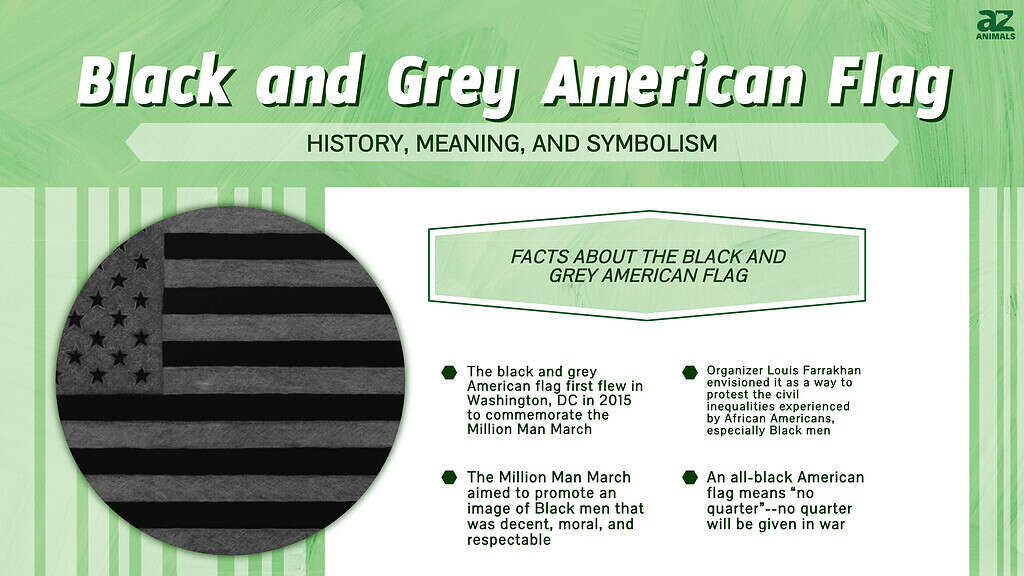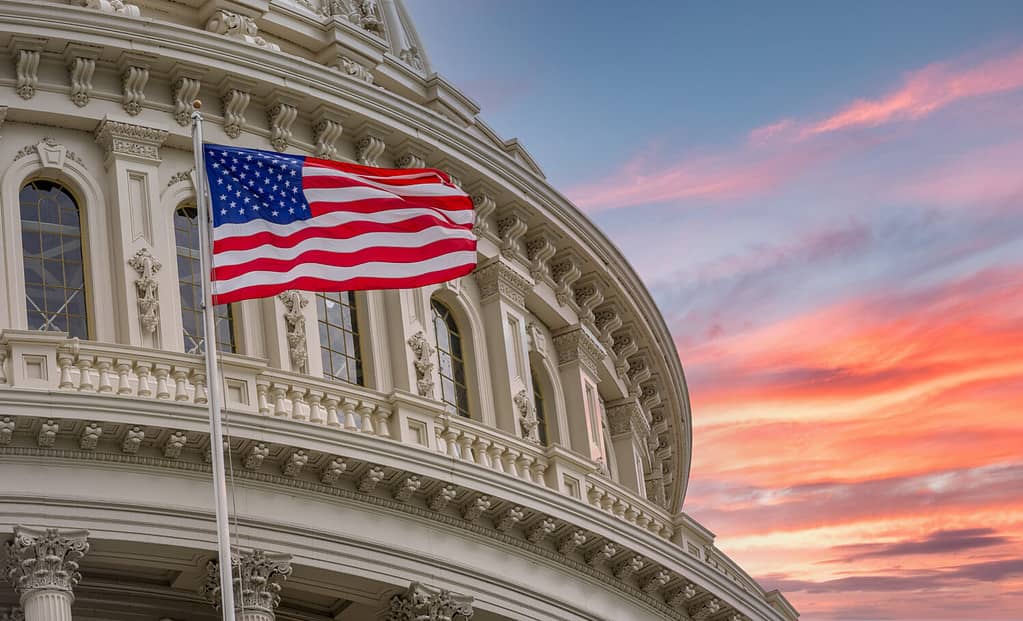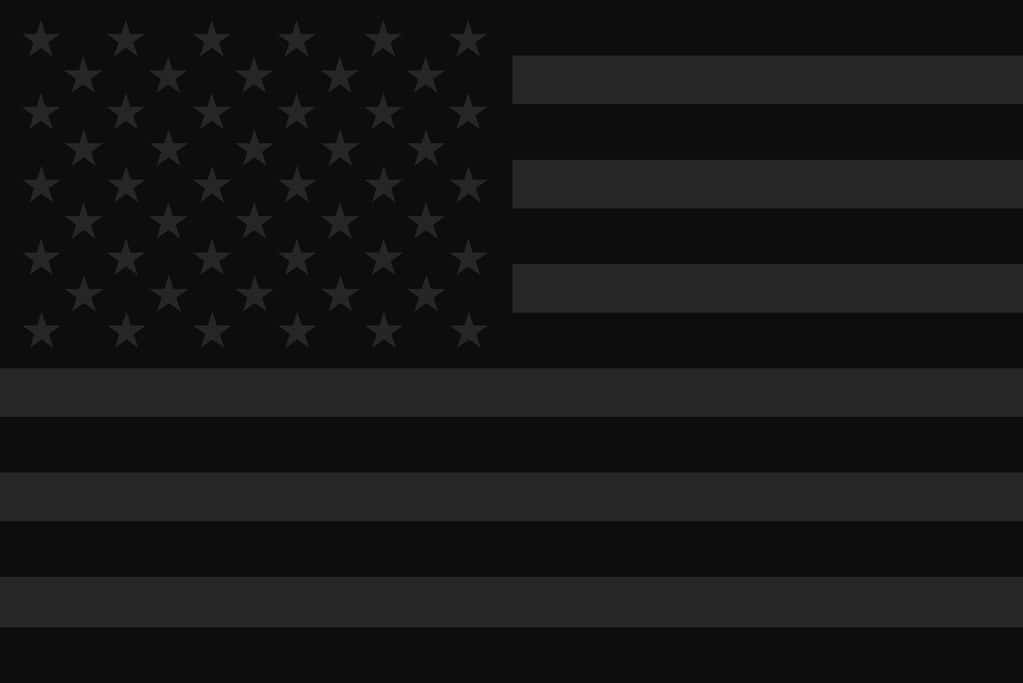A variety of American flags exist, each with its own meaning, symbolism, and history. If you’ve seen a black and grey American flag in front of someone’s house, you may be wondering what it represents. Read on to discover the history and meaning behind this unusual version of the American flag!

Black and Grey American Flag: Meaning and Symbolism
The black and grey American flag originated as a symbol of the Million Man March. The March promoted the economic and social rights of African Americans. This version of the flag is now linked to the civil rights movement for racial justice and equality. It also represents the Black Lives Matter movement, which began in 2013.
The History of the Black and Grey American Flag

The black and grey flag, a version of the traditional American flag, symbolizes the fight for racial justice and equality.
©© Getty Images/Photodisc via Getty Images
The black and grey American flag was first flown in Washington, DC in 2015 to mark the 20th anniversary of the Million Man March. This march took place in Washington near the National Mall on October 16, 1995. Organizer Louis Farrakhan envisioned it as a way to protest the civil inequalities experienced by African Americans, especially Black men.
According to reports, between 400,000 and 1.1 million people showed up to march as part of the protest. This made it one of the largest turnouts in American history. The vast majority of marchers were African-American men, many of them Islamic.
Running parallel to the March on the same day was the National Day of Absence. A group of women organized this effort in tandem with March leaders. It encouraged African Americans across the United States who were unable to attend the March to stay home from work, school, and other commitments. Worship services and educational events ran alongside the March with the aim of educating and uniting the Black community.
The Aim of the Million Man March

The black and grey American flag first flew in Washington, DC in 2015 to commemorate the Million Man March.
©tokar/Shutterstock.com
The Million Man March aimed to promote an image of Black men that was decent, moral, and respectable. This stood in contrast to widespread stereotypes that viewed Black men as lazy, immoral, violent, and sexually corrupt. The organizers encouraged men attending the event to help counter these stereotypes by showing themselves to be decent and courteous human beings.
Besides offering a positive image to the broader public, the organizers wanted to inspire Black men to stand up as moral examples in their own communities. They encouraged Black men across America to embrace family values and upright conduct with the aim of uniting and strengthening African-American communities.
Director Spike Lee immortalized the March a year later with his 1996 movie based on the event, Get on the Bus. The movie follows a group of African Americans on their way to the March.
Louis Farrakhan would later lead the 20th anniversary event on October 10, 2015, to mark the occasion of the Million Man March. Much like the March itself, his speech on this commemoratory occasion drew both praise and criticism.
Criticism of the Million Man March
The Million Man March drew criticism from a number of quarters. Many African-American Christians were suspicious of the proceedings while members of the Jewish community alleged that Farrakhan promoted anti-Jewish views.
In addition to this, many Black feminists felt that the March organizers focused too much on men and not enough on women. Notably, there were very few women present at the March. Some went so far as to argue that the March was a vehicle for male sexism and the revival of the patriarchy. A corresponding Million Woman March took place two years later on October 25, 1997, to promote family unity and the viewpoint of Black women in America. Reports estimated that 750,000 Black women took part in the March on the Ben Franklin Parkway in Philadelphia, Pennsylvania.
What Does the All-Black American Flag Mean?

The all-black American flag represents different things including “no quarter,” protest, mourning, and remembrance.
©Bogdan Kurylo/iStock via Getty Images
A different version of the American flag is all black, almost obscuring the stars and stripes. The meaning of this version is markedly different than that of the black and grey flag. The all-black American flag generally symbolizes “no quarter,” meaning that no quarter will be given in war, including to those who surrender or are unable to defend themselves. This places it in stark contrast to the traditional white flag of surrender. Some sources claim that this refers to a future “second civil war,” which would lend it sinister racial undertones.
However, other sources contend that the black flag is a respectful way to mourn fallen soldiers or express refusal to abide by an unjust status quo. Some military members may also wear a dark American flag on their uniforms to show their allegiance without compromising their ability to camouflage.
Conclusion
Whichever version of the American flag you choose to fly, be sure you understand its meaning and history first! For a history of the development of the American flag through the years, check out this article.
The photo featured at the top of this post is © Deacons docs/Shutterstock.com
Thank you for reading! Have some feedback for us? Contact the AZ Animals editorial team.







